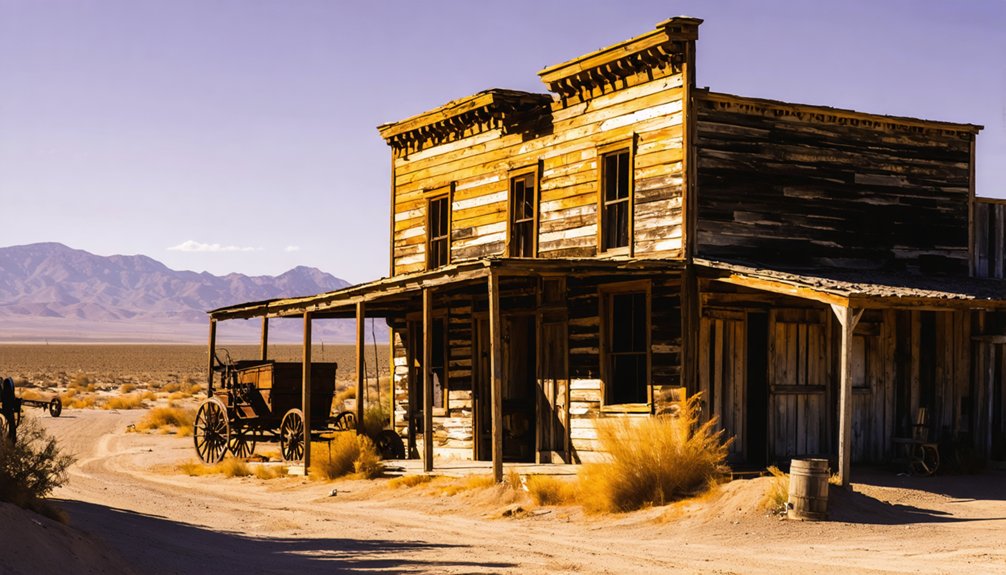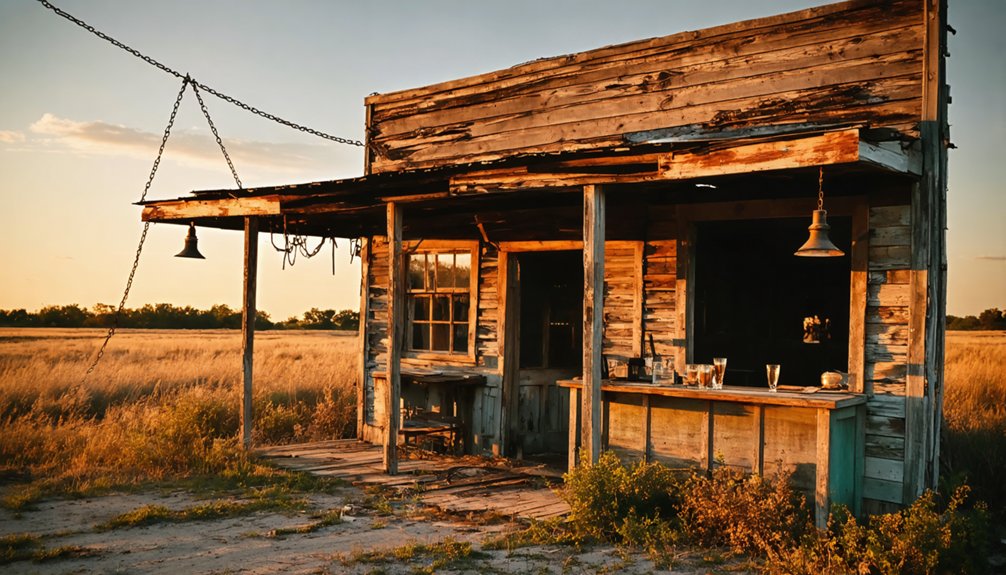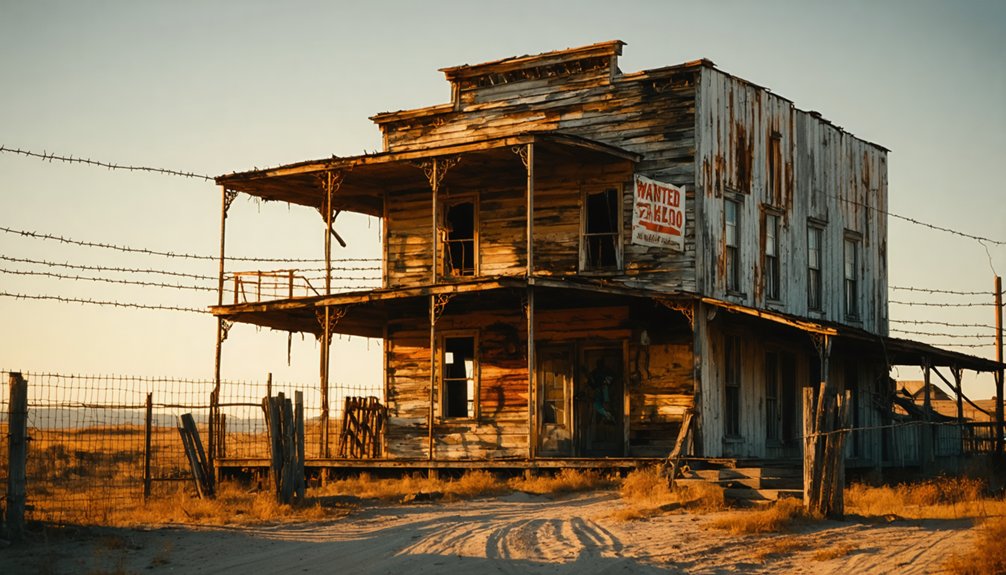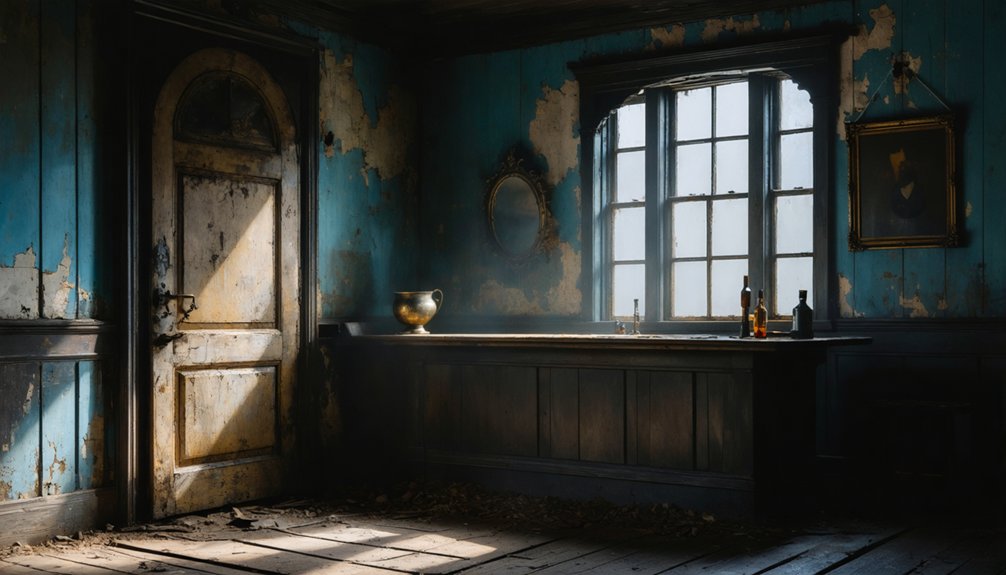When exploring Old West ghost towns, research the destination’s history first to understand its significance. Pack essential gear like sturdy boots, maps, and cameras for remote exploration. Always practice “look don’t touch” to preserve historical integrity—document through photography rather than collecting artifacts. Visit during golden hours for ideal lighting and dramatic imagery. Connect with local historical societies for deeper contextual insights and exclusive access. These approaches will transform your frontier adventure from casual sightseeing to meaningful historical engagement.
Key Takeaways
- Research the town’s history and founding before visiting to understand its significance and layout.
- Pack essential gear including sturdy boots, navigation tools, headlamp, and protective gloves for safe exploration.
- Follow a “look don’t touch” approach and document discoveries through photography rather than taking artifacts.
- Visit during golden hours for optimal lighting and use a variety of lenses to capture the town’s spirit.
- Connect with local historical societies for access to archives, guided tours, and preservation opportunities.
Research Your Destination’s History Before You Go
While the allure of abandoned buildings and empty streets might tempt you to commence your ghost town adventure immediately, thorough historical research beforehand will transform a simple sightseeing trip into a profound historical journey.
Investigate the town’s founding era to understand its architectural style and layout. Identify the primary industries that fueled its existence—whether mining, railroads, or agriculture.
Knowing when a town was established reveals why buildings look as they do and how streets were arranged.
Learn about key historical events and figures that shaped its rise and decline. This context reveals the town’s historical significance beyond weathered structures.
Don’t overlook local legends and cultural backgrounds of former residents. Many towns like Spokane and Galena were completely abandoned by 1940s, leaving behind fascinating stories waiting to be discovered. Check resources like regional historical societies, specialized websites, and forums dedicated to ghost towns.
Libraries often house archives with maps and photographs that illuminate the authentic stories behind these forgotten places. When planning your visit, always inform someone about your intended route and expected return time for safety.
Pack Essential Gear for Remote Exploration
Armed with historical knowledge, your next priority must be proper equipment for venturing into these remote, often inhospitable locations. Your gear selection should prioritize navigation, safety, and documentation tools—carry physical maps and a compass alongside GPS devices, as technology often fails in isolated areas.
For protection, wear sturdy boots, heavy-duty gloves, and layered clothing to shield against hazards and temperature fluctuations. Always pack a headlamp and flashlight with spare batteries for dark interiors, and maintain communication readiness with fully-charged devices and power banks. Consider bringing an all-weather pen and notebook to document historical information and personal observations during your exploration.
Effective packing strategies involve using a waterproof backpack with multiple compartments to organize your first-aid supplies, water, snacks, and documentation tools. Capture potential paranormal evidence by including a digital voice recorder to document any unusual sounds or voices during your ghost town visit.
Don’t underestimate basic necessities—dust masks protect against airborne particulates, while sunscreen prevents exposure in these unshaded landscapes.
Preserve History by Practicing “Look Don’t Touch”
Preserving the authentic character of ghost towns requires adopting a strict “look don’t touch” philosophy throughout your exploration.
Resist the urge to collect souvenirs—each displaced item compromises site integrity and accelerates structural deterioration. Historical narratives remain most powerful when artifacts occupy their original context.
Remember that many locations fall under legal protection; unauthorized handling constitutes both trespassing and potential damage to irreplaceable resources.
Instead, document your discoveries through photography and support local preservation societies financially. These organizations employ professional expertise for proper artifact preservation. These sites deserve cultural and historic status to ensure their features remain intact for educational purposes.
Follow established paths to minimize environmental impact on these fragile ecosystems. Your responsible visitation guarantees future generations will experience these haunting remnants of westward expansion.
Weather-beaten furniture and faded photographs found in these abandoned towns create powerful connections to the lives of past inhabitants.
Capture the Spirit Through Thoughtful Photography
Photography transcends mere documentation when exploring ghost towns, offering a powerful medium for preserving memories without disturbing historical integrity. Your camera becomes a storytelling tool, capturing the whispered history of abandoned saloons and weathered storefronts.
For compelling ghost town photography, time your visits during golden hours when angled light accentuates textures and creates dramatic shadows. Employ a variety of lenses—wide-angle for sweeping vistas, prime for intimate details of rusted hinges and faded signage. Consider black and white processing to emphasize timelessness and texture.
Master emotional storytelling by focusing on elements suggesting human presence: half-opened doors, personal artifacts, or empty rocking chairs. Use a tripod for low-light interior shots, and experiment with light painting after sunset to selectively illuminate architectural features. Identifying the unique characteristics of each location will help create more meaningful photographs that stand apart. Always explore with a safety companion to help navigate potential structural hazards while enhancing the shared experience of discovery.
These techniques transform ordinary snapshots into evocative visual narratives of the American West.
Connect With Local Historical Societies for Deeper Insights
Why limit your ghost town exploration to surface observations when local historical societies offer gateways to profound understanding?
These historical partnerships provide access to extensive archives containing photographs, maps, and documents that reveal nuanced narratives about abandoned settlements. By engaging with society-led preservation opportunities, you’ll contribute directly to protection efforts while gaining privileged access to restoration projects and legal information governing these fragile sites. The Ghost Town Club of Colorado’s Preservation Fund supports numerous historical sites that might otherwise be lost to time.
Societies frequently organize guided tours and educational programs that contextualize ghost towns within broader Old West economic and cultural frameworks, counteracting common misconceptions with scholarly accuracy.
Their interpretive resources—from digital archives to 3D mapping—enhance your comprehension of architectural significance and settlement patterns. For sites like Independence Ghost Town, online archives feature historical photographs and maps that tell the story of its boom-and-bust cycle. Additionally, connecting with these organizations introduces you to networks of fellow enthusiasts and preservationists, potentially opening doors to exclusive experiences unavailable to casual visitors.
Frequently Asked Questions
How Do I Identify Authentic Ghost Towns Versus Tourist Attractions?
Examine authentic architecture showing natural decay rather than restoration. Research historical significance through population data and economic collapse evidence. True ghost towns contain minimal modern amenities and few current residents.
Are Nighttime Visits Safer During Summer Heat in Desert Locations?
Grab your night-vision goggles! While nighttime temperatures are lower, desert safety concerns actually intensify after dark due to limited visibility, increased wildlife activity, and emergency response challenges—offsetting the heat-related benefits.
What Wildlife Hazards Might I Encounter in Abandoned Structures?
You’ll encounter rattlesnakes, rodents, bats, scorpions, and venomous spiders in abandoned structures. These wildlife encounters present significant risks alongside structural hazards like unstable floors concealing animal habitats.
How Can I Distinguish Between Safe and Unstable Historic Buildings?
Like weathered pages in time’s book, you’ll identify safe structures by checking for intact walls, level foundations, and absence of cracks. Building stability depends on undamaged support elements, while compromised structural integrity shows through sagging roofs.
Should I Bring Children to Explore Ghost Towns?
You should bring children to select ghost towns that prioritize child safety with maintained walkways and barriers. They’ll gain rich educational opportunities through tactile historical experiences beyond classroom learning.
References
- https://en.wikipedia.org/wiki/Ghost_town
- https://hiddenbritainse.org.uk/what-i-learned-from-ghost-town-exploration/
- https://www.geotab.com/ghost-towns/
- https://m.dresshead.com/files/scholarship/Documents/Ghost_Towns_Lost_Cities_Of_The_Old_West_Shire_Usa.pdf
- https://www.legendsofamerica.com/gt-hiddentales/
- https://truewestmagazine.com/article/old-west-ghost-towns/
- https://www.britannica.com/topic/ghost-town
- https://westernmininghistory.com/664/what-is-a-ghost-town-wmh-town-classifications-explained/
- https://wildwestcity.com/old-west-ghost-towns/
- https://www.blackhillsbadlands.com/blog/post/old-west-legends-mines-ghost-towns-route-reimagined/



